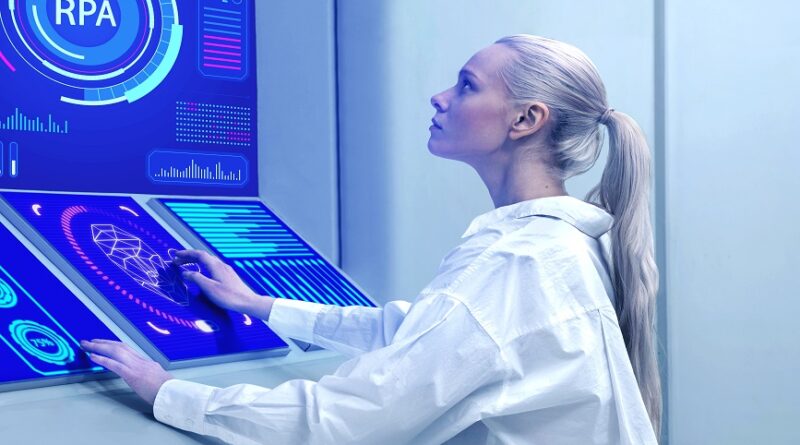Robotics Process Automation(RPA)
Robotic Process Automation (RPA) is a technology that uses software robots or artificial intelligence (AI) workers to automate repetitive, rule-based business processes. RPA bots mimic human actions to complete tasks such as data entry, data extraction, and data analysis. They can be programmed to perform specific functions, interact with other systems and software, and communicate with humans.
RPA bots can work 24/7 without interruption and can perform tasks faster and more accurately than humans, reducing the likelihood of errors and increasing efficiency. RPA can be used in various industries and functions, including finance, healthcare, customer service, and supply chain management.
How does it work?
RPA works by automating repetitive, rules-based tasks using software robots or bots. By automating these tasks, organizations can achieve greater efficiency, cost savings, and improved performance.
Identify a task to automate: The first step in implementing RPA is to identify a task or process that is repetitive, rules-based, and well-defined.
Design the automation workflow: Once the task has been identified, the next step is to design the automation workflow. This involves breaking down the task into a series of steps that the RPA bot can perform.
Develop the automation script: Using RPA software tools, the automation script is developed. The script defines the actions that the bot will take to complete the task, such as opening a specific application, entering data into a form, and submitting the form.
Train the bot: The bot needs to be trained to perform the task accurately and efficiently. This involves setting up parameters such as data sources, error handling, and reporting.
Test the bot: Before deploying the bot, it needs to be tested to ensure that it can perform the task accurately and efficiently. This involves testing the bot on a variety of scenarios and inputs.
Deploy the bot: Once the bot has been tested and is ready to go, it can be deployed to perform the task automatically. The bot can be configured to run on a schedule, triggered by a specific event, or operated manually.
Monitor and maintain the bot: After deployment, the bot needs to be monitored and maintained to ensure that it continues to perform the task accurately and efficiently. This involves monitoring the bot’s performance, making updates to the automation script as needed, and providing ongoing support.
Real-life scenarios:
Finance and Accounting: RPA is being used in finance and accounting to automate tasks such as accounts payable and receivable, financial reporting, and bank reconciliations. This can help reduce errors and improve accuracy while freeing up employees to focus on more complex tasks.
Human Resources: RPA is being used in human resources to automate tasks such as onboarding, offboarding, and benefits enrollment. This can help reduce the time and cost associated with these tasks while improving the employee experience.
Customer Service: RPA is being used in customer service to automate tasks such as order processing, returns, and refunds. This can help improve response times and reduce errors while freeing up employees to focus on more complex customer interactions.
Healthcare: RPA is being used in healthcare to automate tasks such as patient registration, insurance verification, and medical coding. This can help reduce errors and improve accuracy while freeing up medical staff to focus on patient care.
Manufacturing: RPA is being used in manufacturing to automate tasks such as supply chain management, inventory management, and quality control. This can help reduce errors and improve efficiency while freeing up employees to focus on more complex tasks.
Benefits:
Increased efficiency: RPA can automate repetitive tasks, freeing up employees’ time to focus on more important tasks that require human intelligence and decision-making.
Cost savings: By automating tasks that were previously done by human workers, RPA can reduce labor costs and improve productivity.
Improved accuracy: RPA bots can perform tasks with a high degree of accuracy, reducing errors and improving the quality of work.
Increased speed: RPA bots can perform tasks faster than human workers, which can lead to faster turnaround times and improved customer satisfaction.
Improved compliance: RPA can help ensure that tasks are performed consistently and in accordance with regulatory requirements, reducing the risk of non-compliance and associated penalties.
Scalability: RPA can be easily scaled up or down as needed to meet changing business needs.
Future Scope:
Integration with other technologies: RPA can be integrated with other emerging technologies, such as blockchain and the Internet of Things (IoT), to create more advanced automation solutions that can transform entire industries.
Increased adoption across industries: While RPA is already being used across a range of industries, there is still significant potential for growth and adoption. As more organizations realize the benefits of RPA, we can expect to see increased adoption across industries.
Enhanced user experience: As RPA becomes more intelligent and sophisticated, it can be used to improve the user experience for customers and employees. This can include automating customer service interactions, improving response times, and reducing errors.




